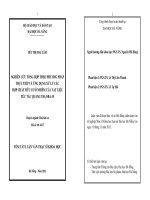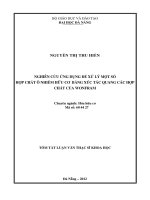Chuong 5 ung dung xuc tac quang
Bạn đang xem bản rút gọn của tài liệu. Xem và tải ngay bản đầy đủ của tài liệu tại đây (825.67 KB, 12 trang )
Chƣơng 5
ỨNG DỤNG XÚC TÁC QUANG TRONG XỬ LÝ MÔI TRƢỜNG
1. Introduction
Bases of photocatalytic enhancement
Improvement of
1. Absorption of photons to create electron–hole pairs
photon absorption
2. Separation and migration of the
photogenerated electrons and holes; either
migration to surface reaction sites (ii)a, or
recombination (ii)b.
Reduction of
recombination
3. Surface chemical reactions, for which
surface character (active sites) and
quantity (surface area) are important
Main processes in semiconductor heterocatalysis
Activation of surface
CARBON 49 (2011) 741
Improvement of photon absorption
Metal or Nonmetal doping
Schematic band structures of a metal oxide
(NaTaO3) and metal (oxy)nitride (BaTaO2N).
J. Phys. Chem. C 2007, 111, 7851-7861
Sensitization
Mechanism of dye-sensitized photocatalytic
hydrogen production under visible light irradiation
Renewable and Sustainable Energy Rev. 11 (2007) 401
Structural model for the CdTi nanohybrid
Seong-Ju Hwang, et al. Adv. Funct. Mater. 2011, 21, 3111
Reduction of recombination
Reducing of particle size
Decreasing particle size reduces the probability of
electron–hole recombination due to reduced
migration distances and fewer defects
CARBON 49 (2011) 741
Metal deposition
Metal deposition particles can act
as electron trapping to reduce the
recombination rate of
photogenerated electron-hole pairs
Applied Catalysis A: General 325 (2007) 1
Activation of surface
Increase of active sites
Co-catalyst
Schematic illustration of overall water splitting
on a heterogeneous photocatalyst
Chem. Mater. 2010, 22, 612–623
Increase of surface area
Reducing particle size or using
porous materials
TEM micrograph of TiO2 nanoparticles in
a microporous region of activated carbon
CARBON 49 (2011) 741
CƠ CHẾ PHẢN ỨNG XÚC TÁC QUANG TRONG
XỬ LÝ CÁC HỢP CHẤT HỮU CƠ
Effect of operating parameters on the degradation of
pesticides and phenols
1. Types and composition of photocatalyst
2. Influence of substituent group
3. Light intensity and wavelength
4. Pollutant type and concentration
5. Catalyst loading
6. Medium pH
7. Synthesis technique and calcination temperature
8. Doping and mixed semiconductor
9. Interfering substances
10. Oxidants/electron acceptor
11. Mode of application: suspended vs. immobilized system









